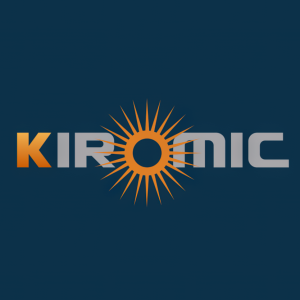Kiromic Announces the Filing of Key European Patents for Its Chimeric PD-1 (chPD1) Target
Kiromic Biopharma (Nasdaq: KRBP) has announced the filing of crucial European patents for its chimeric PD-1 (chPD1) target, focusing on immuno-oncology. The chPD1 receptor interacts with PD-1 ligands on various cancer cells, including those from ovarian and breast cancers, activating T-cells to destroy tumors. Preclinical data shows a 100% long-term progression-free survival rate in nine in vivo models. Kiromic's chPD1 will enhance their CAR-T therapy platform, led by Prof. Amorette Barber from Longwood University, aiming for significant advancements in cell therapies.
- Filing of European patents for chPD1 target could strengthen market position.
- Preclinical data indicates a 100% long-term progression-free survival rate in nine models.
- Collaboration with Prof. Amorette Barber may accelerate clinical development.
- None.
Kiromic Biopharma, Inc. (Nasdaq: KRBP), a target discovery and gene-editing company utilizing artificial intelligence and proprietary neural network platform with a therapeutic focus on immuno-oncology, announces the filing of key European patents for its chimeric PD-1 (chPD1) target.
- Kiromic chPD1 receptor targets PD-1 ligands expressed on many different types of cancer cells, including ovarian, pancreatic, prostate, colon, kidney, and breast cancer and melanoma.
- Kiromic chPD1-expressing T-cells engage with the PD-1 ligands on the surface of the cancer cells and this interaction activates the T-cells to directly kill the tumor cells.
-
Kiromic chPD1 has shown in preclinical data to show a cytotoxic response in 9 different in vivo models with
100% long-term PFS with the induction of host memory responses. - chPD1 will be used in the Company’s proprietary chimeric antigen receptor therapy (CAR-T) platform using gamma-delta T-cells (GD-T).
Kiromic’s deep understanding of the tumor micro environment (TME) and the tumors' escape and masking mechanisms led to development of a promising platform for chimeric antigen receptor therapy (CAR-T).
We believe our allogenic CAR-T platform is significantly stronger with chPD1 target licensed from Longwood University.
Prof. Amorette Barber of Longwood University will be heading up our chPD1 program.
"We believe Prof. Barber's work will give Kiromic a significant acceleration in the clinical development of its therapy platform and an even more significant advantage over its competitors. We believe this collaboration marks the beginning of an exciting revolution in cell therapies," said Gianluca Rotino, Chief of Strategy and Innovation Officer.
"chPD1 is an exciting and differentiated target for our allogenic CAR-T solid tumors platform. We look forward to updating you in the months ahead as we move closer to filing our first IND with our chPD1 for ovarian cancer," said Maurizio Chiriva-Internati, PhD, CEO of Kiromic Biopharma.
About PD-1 Check-point inhibition
PD-1 has always been a challenge for CAR-T development. PD-1 is the brakes of the immune system, inhibiting immune cells from killing tumor cells.
Traditional PD-1 inhibitors block the PD-1 receptor, “removing the brakes” of T-cell activity. Conversely, Kiromic’s chPD1 not only “removes the brakes” but also engages the PD-1 receptor to “accelerate” T-cell activity.
About Kiromic chPD1 Mechanism of Action
Kiromic’s chPD1 receptor targets PD-1 ligands expressed on many different types of cancer cells, including ovarian, pancreatic, prostate, colon, kidney, and breast cancer and melanoma.
Chimeric PD-1-expressing T-cells engage with the PD-1 ligands on the surface of the cancer cells and this interaction activates the T-cells to directly kill the tumor cells. Chimeric PD-1 T-cells also release cytokines to further initiate immune responses to eradicate the tumor cells.
Through expression of the chPD1 receptor, the inhibitory signal the T-cells would have received through engagement of the PD-1 ligands on tumor cells now acts as an activating signal and induces destruction of tumors. A large variety of cancer types express PD-1 ligands thus the chPD1 T-cells could potentially be used to treat many types of tumors.
About Dr. Amorette Barber (Longwood University)
Dr. Barber is an associate professor of biology and director of the Office of Student Research. Dr. Barber is in her tenth year at Longwood and serves as the President-Elect of the Virginia Academy of Science.
Dr. Barber is a tumor immunologist. She is an expert in chimeric antigen T-cells. Her research focuses on determining the role costimulatory domains play in enhancing chimeric T-cell activity and the creation and testing of the chPD1 receptor as a therapy for multiple types of cancer.
Dr. Barber has had 26 publications in cellular signaling in the following scientific journals: The Journal of Clinical Investigation, Blood, Cancer Research, The Journal of Immunology, and many others.
Link to her profile: http://www.longwood.edu/directory/profile/barberarlongwoodedu/
Dr. Barber also serves on Kiromic’s Scientific Advisory Board.
About Longwood University
Longwood has a robust research department with 7 post doctorates conducting research in molecular biology, microbiology, genomics, cancer biology, and immunology and publishing over 75 publications in different scientific journals in the past 5 years.
Link to Longwood University: www.longwood.edu
About Kiromic
Kiromic BioPharma, Inc. is a preclinical stage biopharmaceutical company which is focused on discovering, developing, and commercializing novel immune-oncology applications through its robust product pipeline. The pipeline development is leveraged through the Company’s proprietary target discovery engine called "DIAMOND." Kiromic's DIAMOND is big data science meeting target identification, dramatically compressing man-years and billions of drug development dollars to develop a live drug. The Company maintains offices in Houston, Texas.
For more information, please visit the company’s website at www.kiromic.com.
Forward-Looking Statements
This press release contains forward-looking statements that involve substantial risks and uncertainties. We make such forward-looking statements pursuant t
FAQ
What is Kiromic Biopharma's recent patent filing about?
What cancer types does Kiromic's chPD1 receptor target?
What are the results of Kiromic's chPD1 in preclinical studies?
Who is leading the chPD1 program at Kiromic?







